Solidarity in the Second Hand Supply Chain
This is a guest blog post by The OR Foundation, a movement for a justice-led circular economy. During Second Hand September, we shared a range of ‘Myth vs. Fact’ content unpicking some common misconceptions about the secondhand clothing trade. We also hosted a panel event, Solidarity in the Secondhand Supply Chain, featuring key stakeholders from across the industry to build constructive debate on the future of resale and recycling.
Myth #1: The global secondhand clothing trade is charity. The global secondhand clothing trade is recycling.
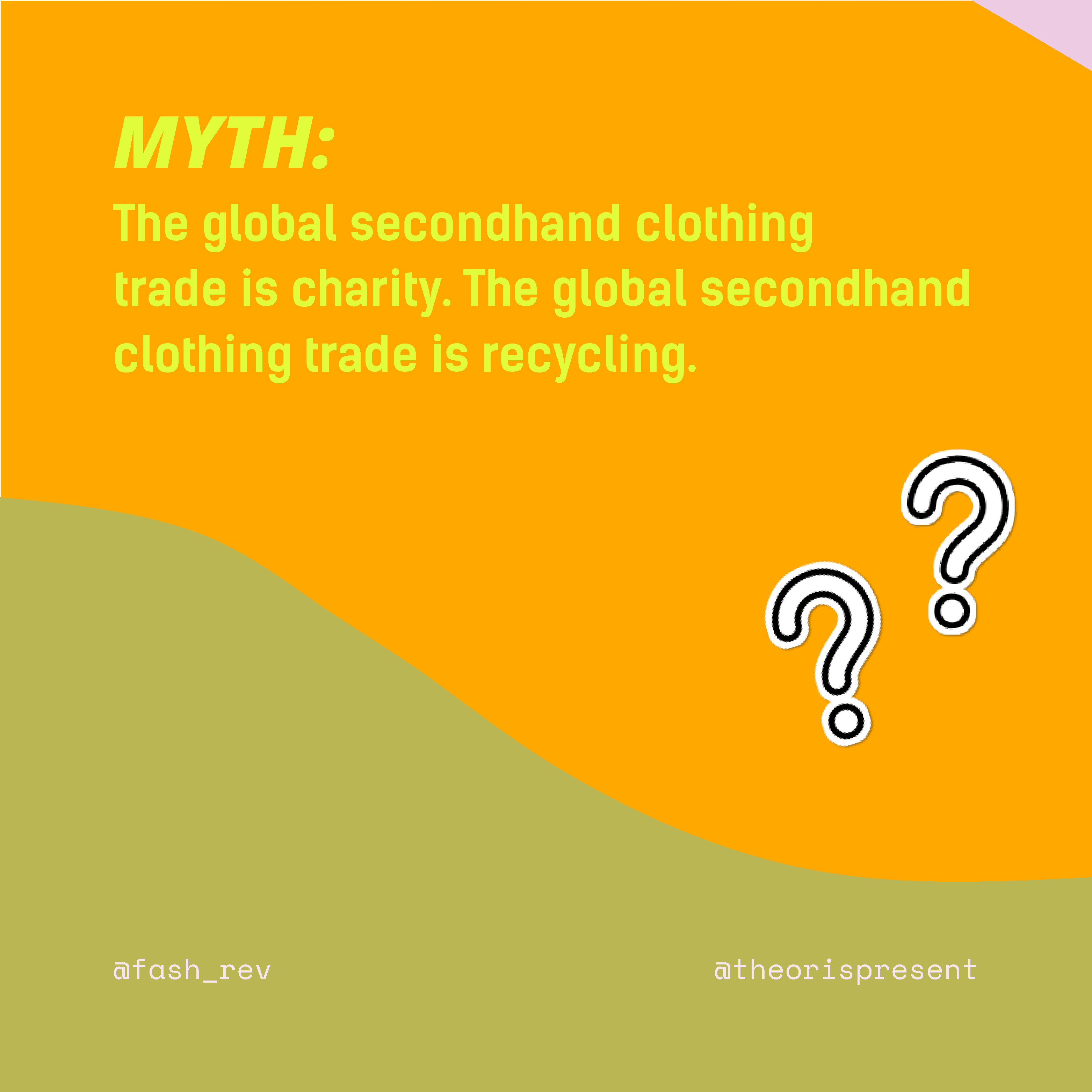
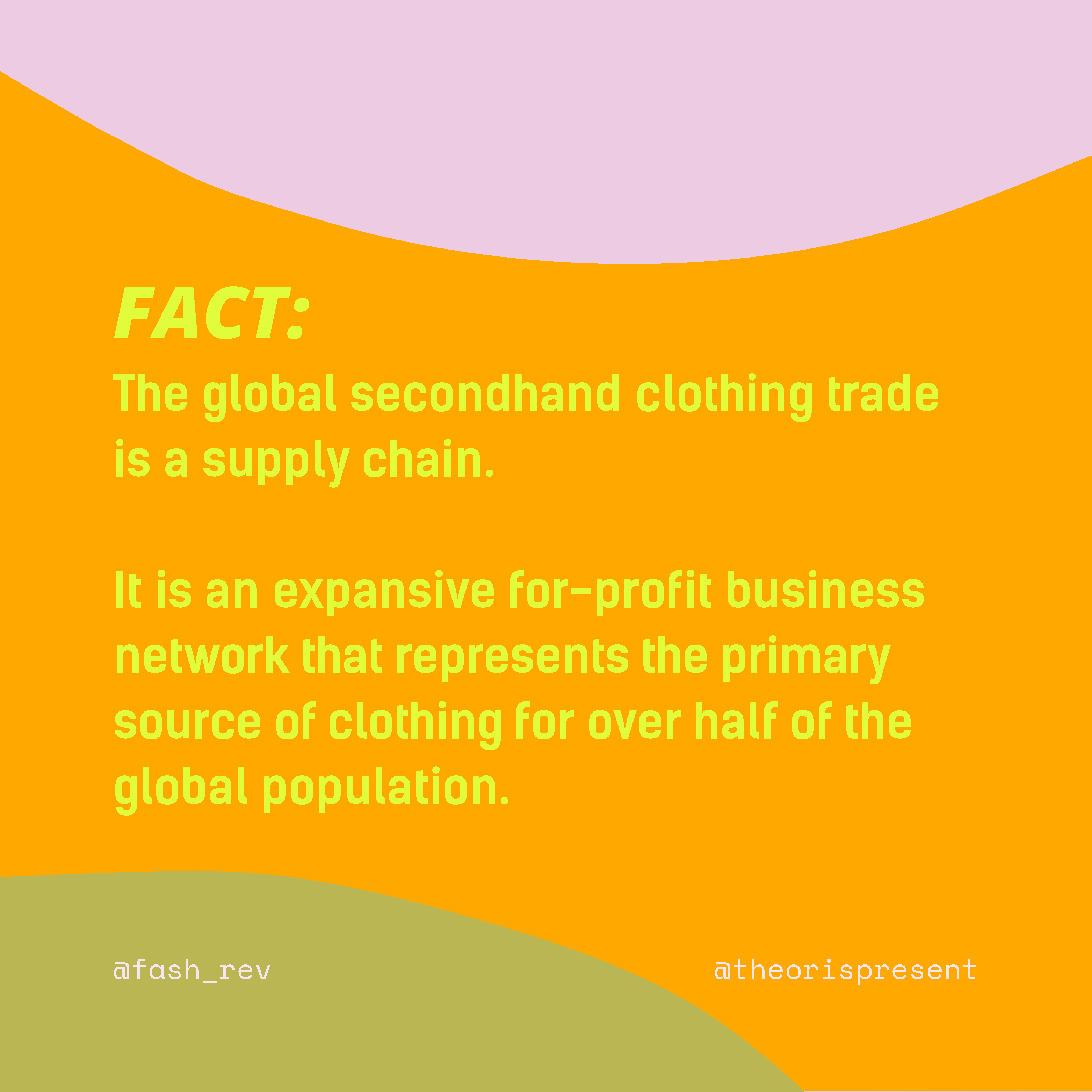
The global secondhand clothing trade is a supply chain. It is an expansive for-profit business network that represents the primary source of clothing for over half of the global population.
The secondhand clothing trade has long been marketed as charity, but it has always been a for-profit outlet for the Global North’s excess. Clothing is not given out for free to those in need. You might donate your clothing for free, but it still costs money to collect, sort, grade, stock, resell and transport secondhand clothing and the people investing money in those activities expect to make a profit in return.
Secondhand retailers in the Global North can only sell about 10-20% of what they collect in the country of consumption. Most of the clothing donated in the Global North will pass through multiple hands in multiple countries before ultimately being exported to the Global South where retailers purchase individual bales. Retailers in Kantamanto spend between $75-500 per bale, many taking out loans to purchase the clothing.
While you may look at the Made In tag on your clothing to define the ‘country of origin’, for many people in the Global South, the country of origin is the country from which the secondhand bale was exported. Just as there is a value chain of farms, mills and factories that participate in manufacturing new clothing, so too is there a chain of brands, consumers, charities, resale platforms, graders and exporters that make up the secondhand supply chain.
Today many brands are rebranding the secondhand clothing trade by using the language of “recycling” or “circularity”. Typically when people think of recycling they think of old garments being turned into new garments, but the majority of what is collected by most brands is simply diverted into the secondhand clothing trade, with the bulk of these items being exported to the Global South. Many garments are resold and upcycled through resale markets like Kantamanto, but nearly just as many become waste. Kantamanto sees 15 million garments a week, and 40% leave as waste. The clothing that is exported to secondhand markets in the Global South is not recycled into new textiles.
Framing the secondhand trade as either charity *or* recycling centres the perspective of the sender (the person giving away an item) and perpetuates an abstract, depoliticized narrative that confuses people and provides an excuse for overproduction and overconsumption. Understanding the secondhand clothing trade as a supply chain pushes us to ask the same questions of the secondhand trade that we ask of the new clothing trade, including questions about the labour involved. Questions like:
- Who sorts the clothing that I drop in my neighbourhood bin?
- Is their job safe?
- Who resells my clothes?
- Do they earn a living wage?
- What is my role within this value chain?
- Is the clothing I buy worthy of many lives?
Understanding the labour involved in today’s system of recirculation is the first step in ensuring safe and dignified employment opportunities in the circular economy of the future.
Myth #2: Waste resulting from the secondhand clothing trade should be the responsibility of those who demanded it.
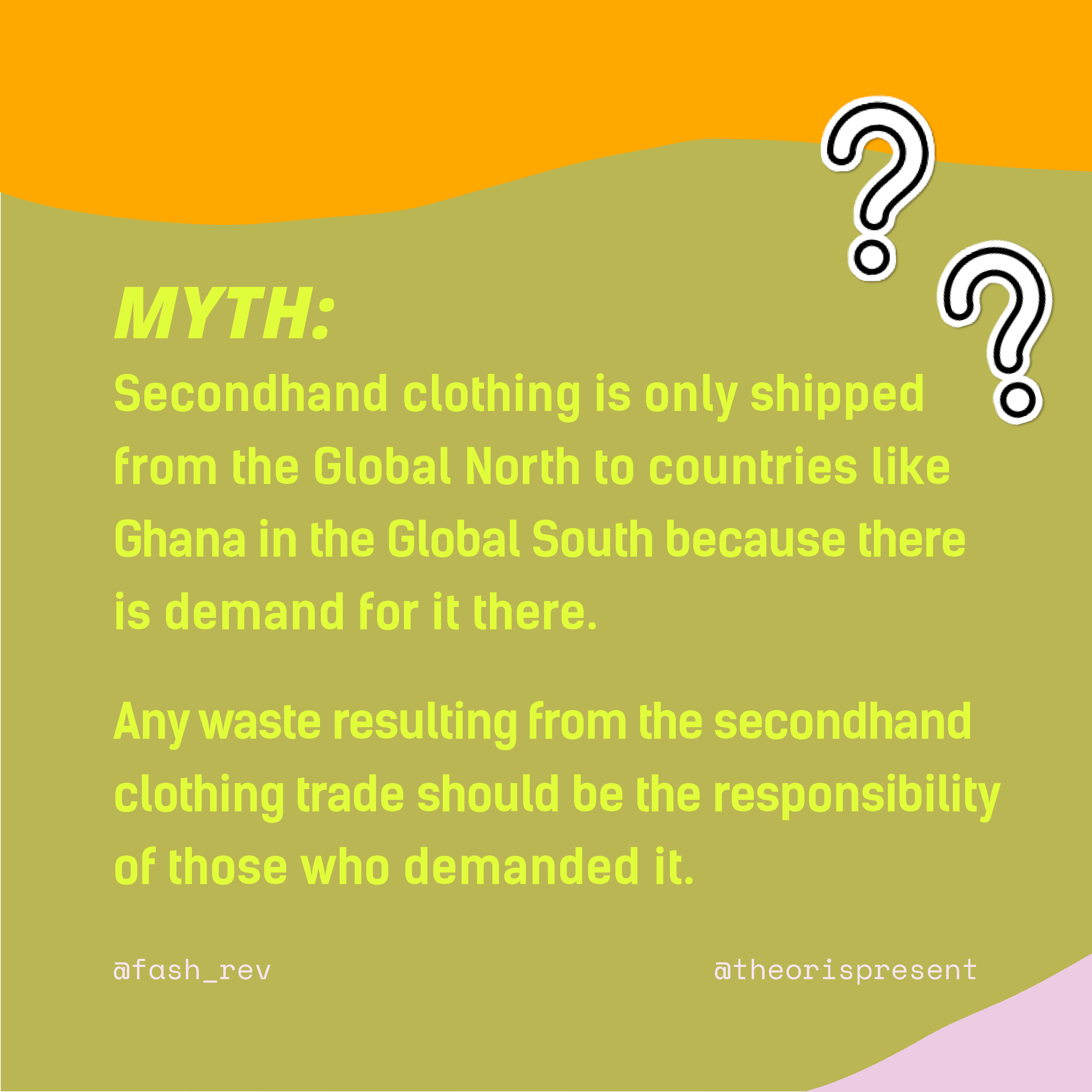
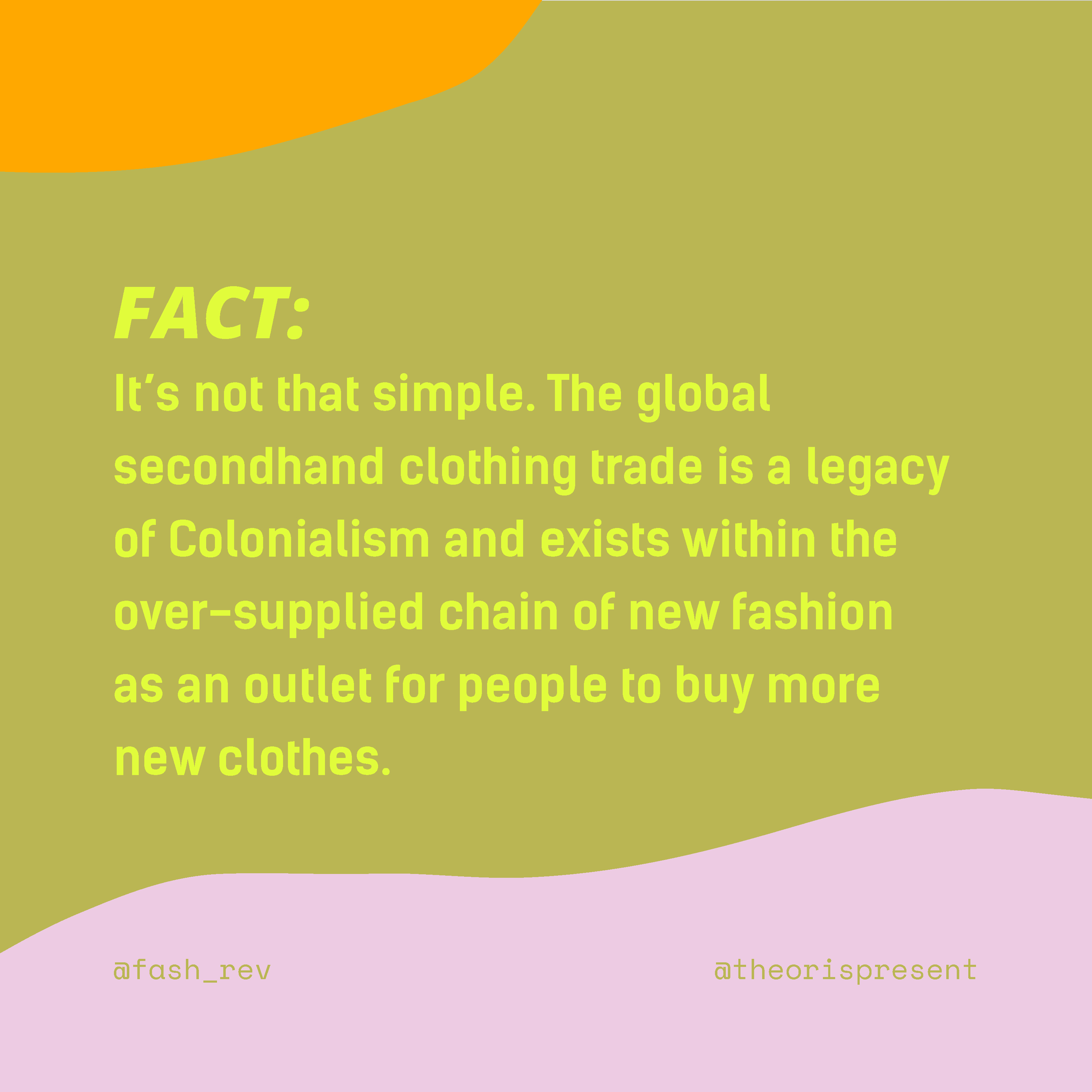
The global secondhand clothing trade is a legacy of Colonialism and exists within the over-supplied chain of new fashion as an outlet for people to buy more new clothes.
Under colonial rule, Ghanaians were expected to conform to professional dress codes as defined by the British. In order to enter certain rooms, to get certain jobs, attend certain schools or to be considered a ‘modern global citizen’, Ghanaians had to forgo their local dress in favour of Western clothing, swapping out sustainably made kente for a shirt and tie. Colonialism created the conditions for conformity. Navigating oppressive colonial rules is a survival mechanism, not an expression of demand. Colonisers profited from those rules by selling hand-me-downs and importing used clothing. This evolved into the secondhand trade we know today.
The global secondhand clothing trade is supply-driven, not demand-driven. The type of garments and quality of clothing available to traders in the Global South is entirely dependent on the quality and care of clothing being produced, purchased, returned, worn and donated in the Global North. The supply-driven nature of the secondhand economy impacts everyone along the value chain, including resale platforms, consignment stores, charities, clothing collectors, graders and exporters in the Global North, but ultimately all of these actors can choose to pass less desirable clothing down the chain to importers and retailers in the Global South.
Generally, importers cannot order a container full of the exact bales that they want and they do not see the specific items they are purchasing. Importers have little negotiating power over what is shipped and they assume that up to ⅓ of the clothing on each container will be difficult to sell (eg. bedsheets, single-use tees and winter clothing) and will likely become waste.
No segment of the fashion industry accurately predicts demand, hence the existence of deadstock and unsold goods. Given the unpredictable nature of clothing donations, the resale economy cannot accurately predict stock levels. But Kantamanto has no outlet for its excess – it is the last link in the oversupplied chain.
Secondhand fashion and textiles have the potential to transform the industry for good, but at present, we are turning blind eye to the hidden actors in the supply chain. The people who sort, recycle and resell our unwanted clothes, and the often unjust systems that underpin their work. The garments that end up as waste in landfill, and the consequences of these rotting fashion mountains on the natural world.
It’s time for a more mindful approach to how we buy, sell, resell and recycle clothing
Myth #3: The secondhand trade stops new fast fashion from being desired and sold.
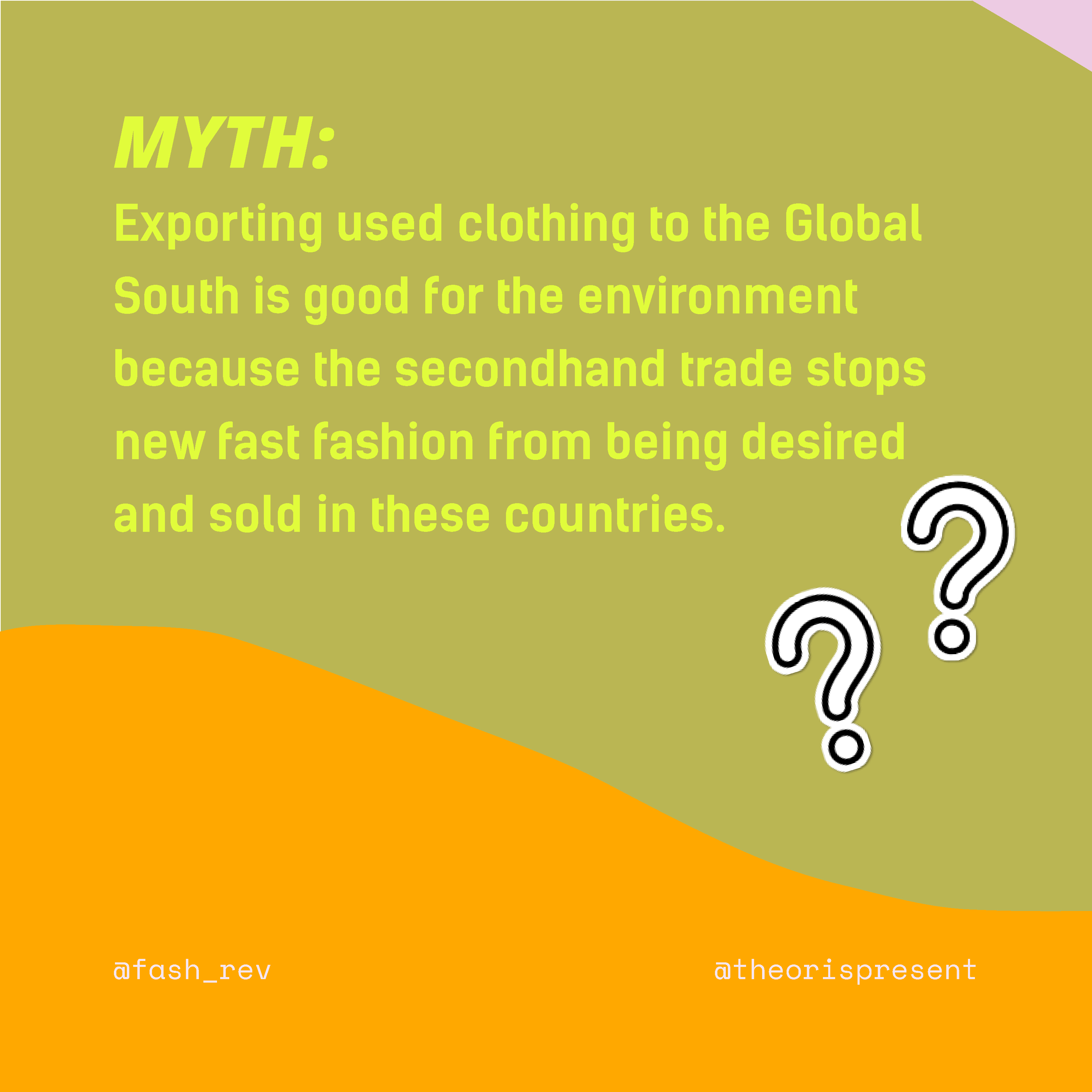
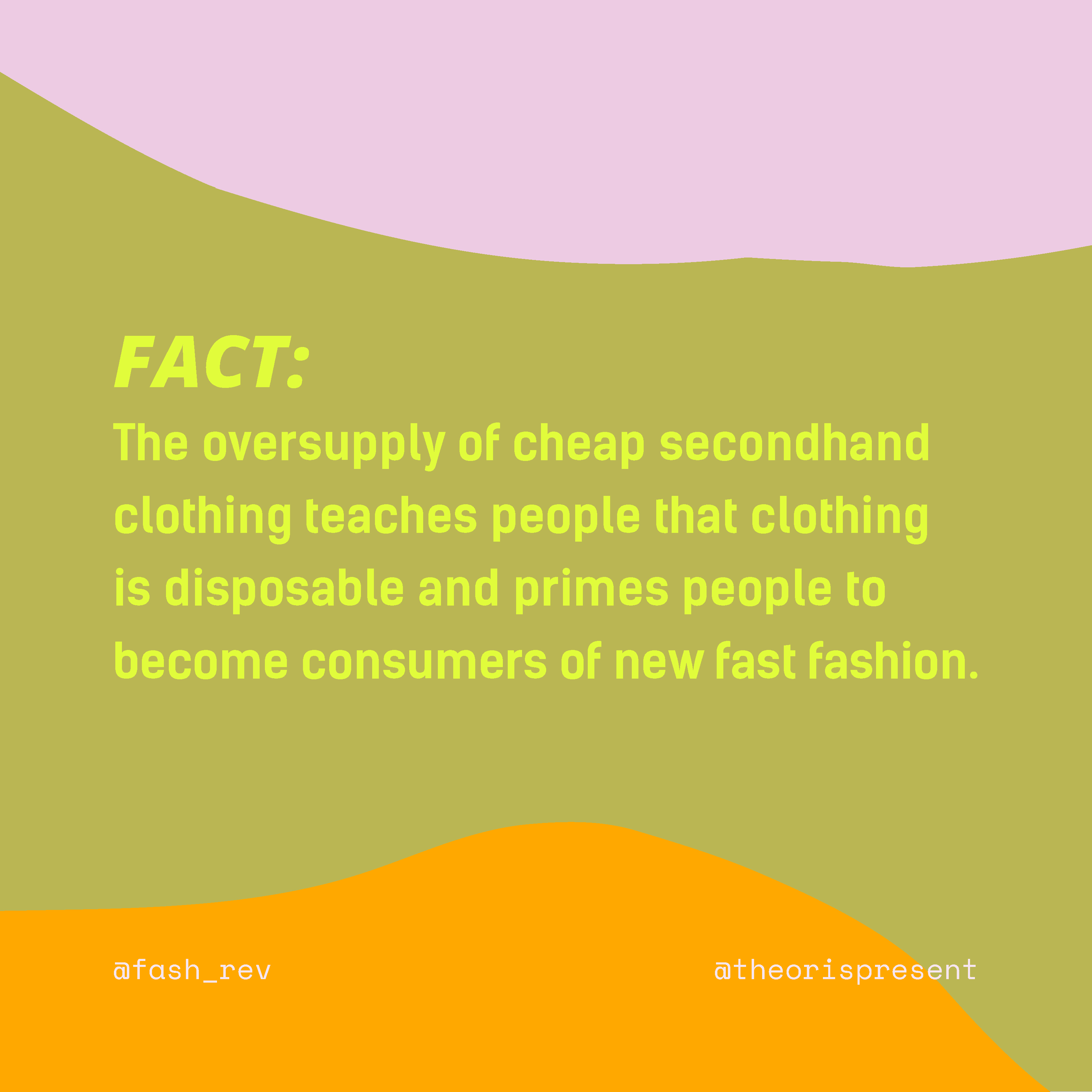
The oversupply of cheap secondhand clothing teaches people that clothing is disposable and primes people to become consumers of new fast fashion. The secondhand clothing trade is seen as an outlet for fashion excess and therefore must operate at the scale and pace of the new clothing industry. Secondhand clothing markets are overwhelmed with cheap fast fashion items. The never-ending supply of non-durable items drives down the perceived value of clothing.
Secondhand retailers struggle to invest in rehabilitating lower quality items, and must keep buying more low-quality clothing to pay off the losses from previous bales. Waste accumulates in the market and in the environment. It is a vicious cycle, one that teaches citizens that clothing is a disposable commodity.
The more the Global North floods the Global South with disposable clothing, the more prolific the attitude that clothing is meant to be cheap and disposable.
Low-quality garments become desirable when brands convince people that investing in convenience is more important than investing in quality. This is bad news for local independent designers and good news for foreign fast fashion companies looking to expand to new markets.
As more people enter the middle class in Ghana, they are ordering clothing from major global retailers, not shopping from local designers.
There is no evidence that the abundant supply of secondhand clothing in the Global North has slowed down the consumption and production of new garments, and there is no evidence that the exportation of secondhand clothing to the Global South has eliminated any desire for new clothing. Instead it has primed new markets to become consumers of fast fashion.
Myth #4: Fashion’s waste crisis is caused by a lack of textile recycling technology.
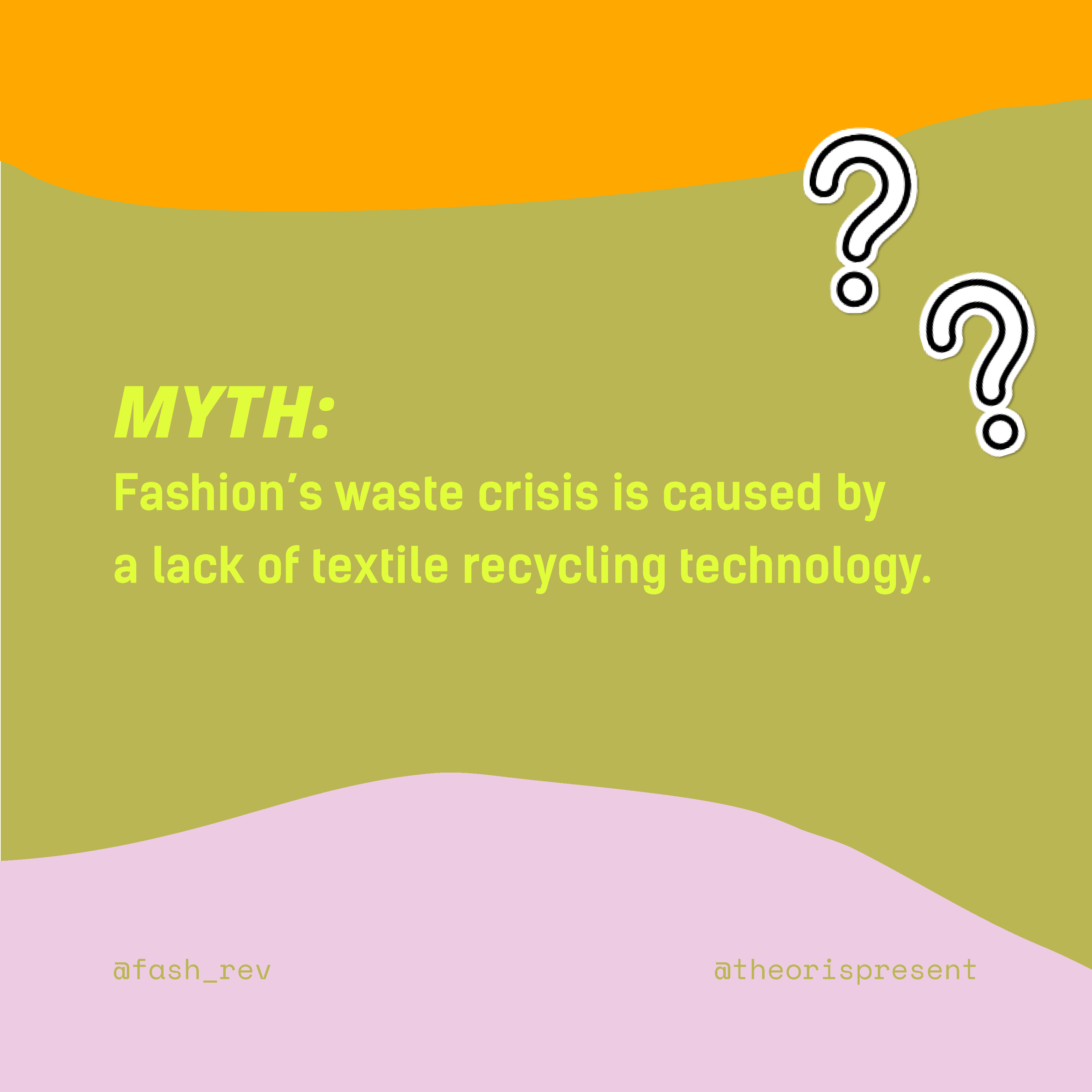
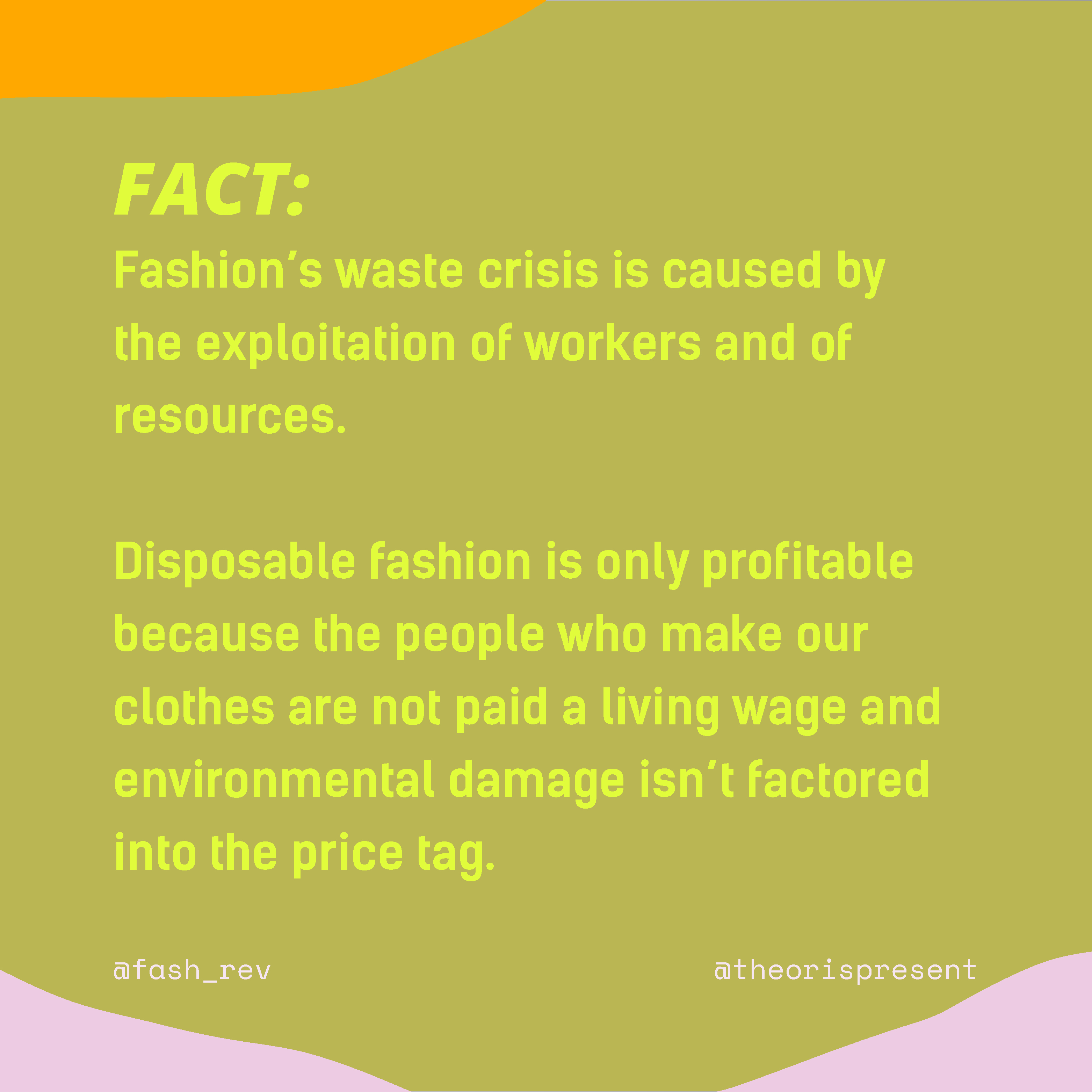
Fashion’s waste crisis is caused by the exploitation of workers and of resources. Disposable fashion is only profitable because the people who make our clothes are not paid a living wage and environmental damage isn’t factored into the price tag.
Fiber-to-fibre recycling is absolutely necessary, but any brand that attempts to blame fashion’s waste crisis on a lack of recycling infrastructure is greenwashing. Brands are not adequately investing in the textile recycling technologies that already exist, and it could also take years before these technologies are able to absorb a meaningful amount of fashion’s excess.
Recycling is not a silver bullet solution that offsets the overproduction of garments and the exploitation of everyone from garment workers to secondhand retailers. We can’t tackle fashion’s waste crisis if the majority of people working in fashion from factories to secondhand markets are indebted to the very system that is exploiting them.
Circular solutions could be the key to a more sustainable fashion industry. But any brand that prioritizes recycling over ensuring that the people growing, sewing, repairing, reselling and upcycling our clothes are earning a living wage is not interested in solving the problem. When brands continue to overproduce while paying lip service to circularity, they are not interested in solving the problem, they are interested in extracting profit from the problem.
The fashion system is built on waste and exploitation, but that waste is not factored into the price tag we see in shops and online stores. We stand for a fair and equitable fashion economy for the people paying the true cost.
Myth #5: Secondhand clothing ends up as waste in the Global South because it is unwearable.
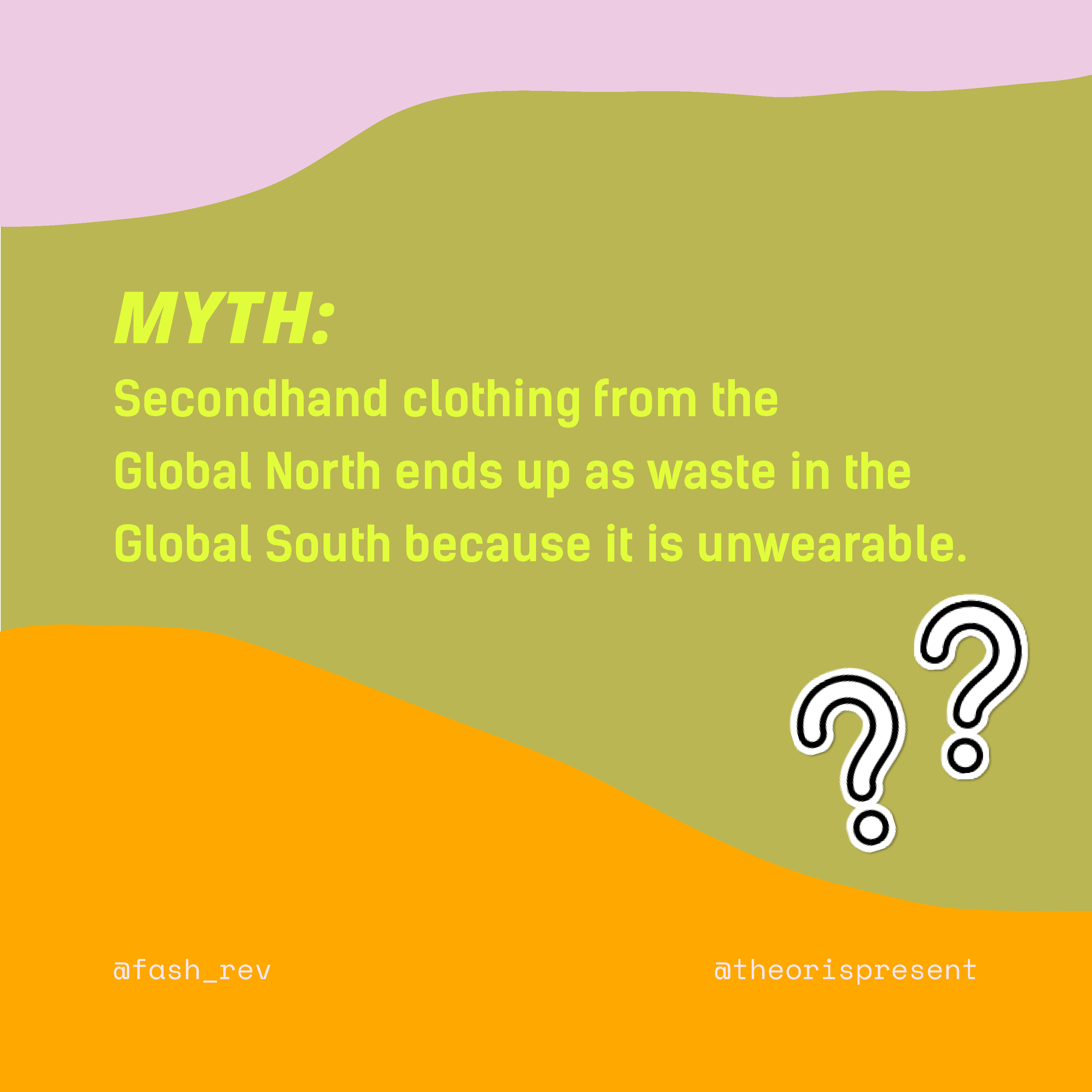
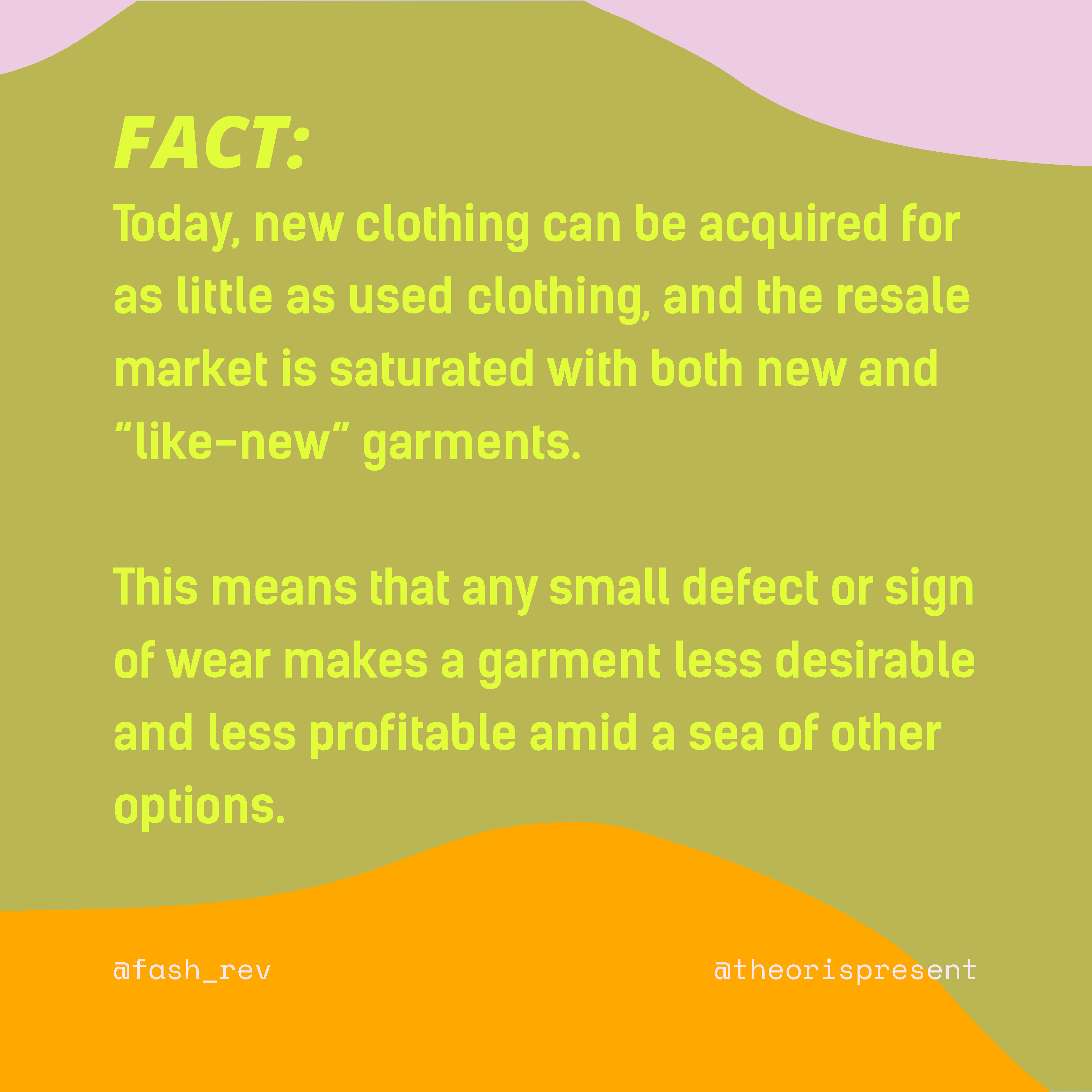
Today, new clothing can be acquired for as little as used clothing, and the resale market is saturated with both new and “like-new” garments. This means that any small defect or sign of wear makes a garment less desirable and less profitable amid a sea of other options.
There are fewer high quality, made-to-last items in circulation, and with the rise of resale in the Global North, more of these items are being extracted from the flow of secondhand goods. This leaves secondhand graders and exporters in the Global South with more low grade items. Roughly 25% of the clothing that enters Kantamanto every week is single-use t-shirts from marathons, hen-dos, conferences and family reunions, many of them faded and stretched.
When retailers in Kantamanto open a bale, they assess the goods, sorting the clothing into four piles called selections. While retailers can sometimes end up with a bale that is completely spoiled due to mould or odour, most bales contain less than 6% trash. This means that 94% of every bale is deemed wearable by Kantamanto retailers. And yet 40% leaves as waste.
Why does so much secondhand clothing end up as waste? In Kantamanto there are two main reasons ↓
1. Kantamanto shoppers know that there is a never ending supply of goods coming through the market. With this in mind, many people buy only the first selection, which is “like new” and makes up only 18% of the average bale. If a retailer is out of first selection, the customer would rather come back the next day when there is a new bale than buy the remaining lower quality garments. Basically, one man’s trash is not another man’s treasure, it’s just trash, regardless of whether it is wearable or not.
2. Because of the decreasing quantity of first selection goods per bale, many retailers have less money to invest in rehabilitating lower quality garments (like a stained and stretched marathon t-shirt) through cleaning, ironing, dyeing, tailoring or upcycling. Instead, retailers have only one option to maintain cash flow — buy another bale. To make room for more stuff they have to get rid of old merchandise. People in need will pick over the waste piles at the end of the day, but there are still far more garments than can even be given away for free. Thus, wearable clothing goes to waste.
There is no market capable of absorbing the excess produced by the fashion industry. The secondhand clothing trade adds an important link to fashion’s supply chain, extending the life of billions of garments every year, but it does not close the loop. The only way to ensure that all garments reach their potential is to slow down production of new clothing and invest in the sharing economy to enable enhanced cleaning, mending, altering and upcycling of what already exists.
Learn more
Solidarity in the Secondhand Supply Chain
The burden of excess: It falls on her
Modern colonialism disguised as donation
Dead White Man’s Clothes








